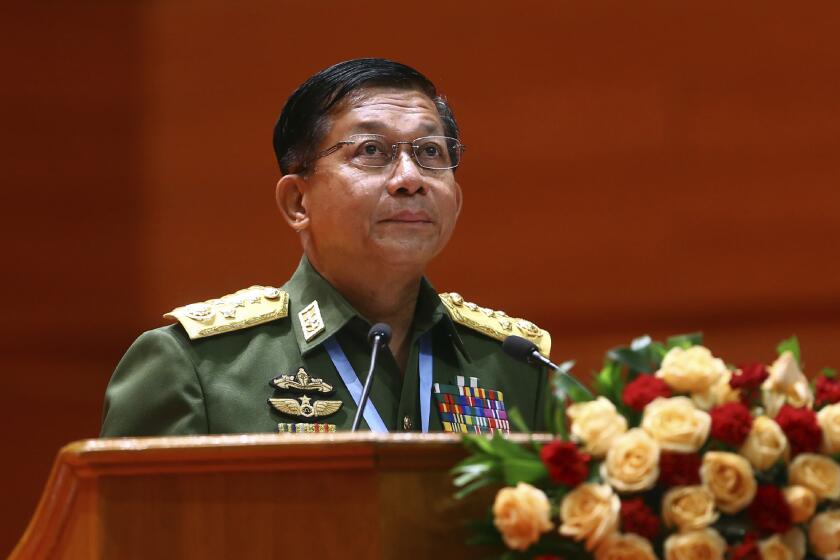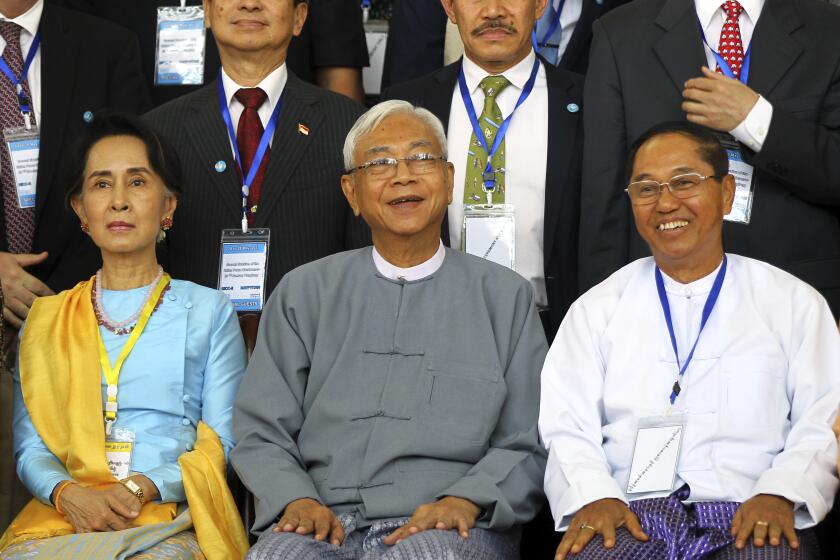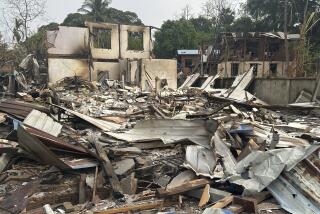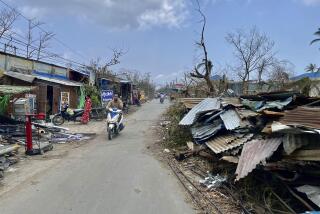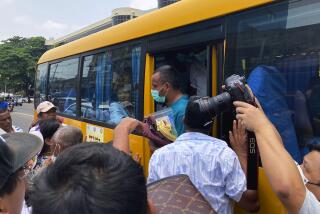2 Myanmar protesters killed by police fire, reports say
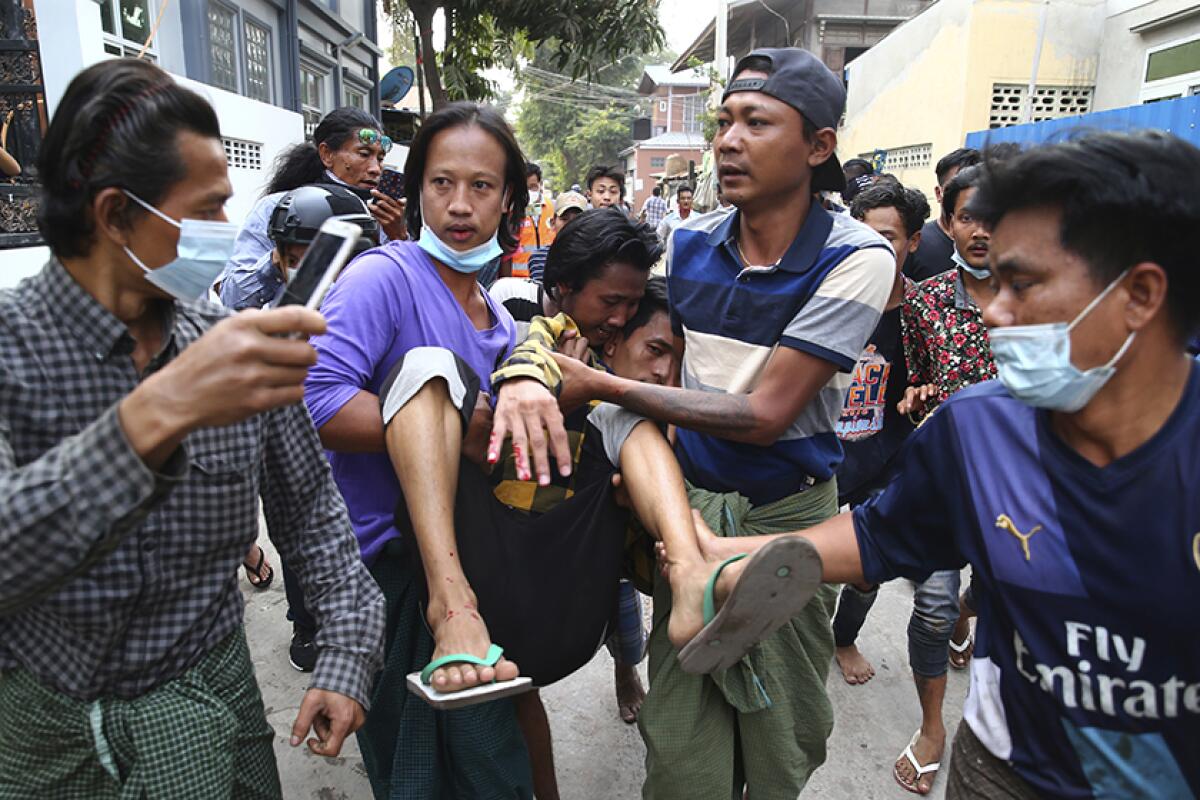
MANDALAY, Myanmar — Two anti-coup protesters were shot dead by riot police who fired live rounds Saturday in Mandalay, Myanmar’s second-largest city, local media reported.
One of the victims was shot in the head and died at the scene, according to Frontier Myanmar, a news and business magazine based in Yangon, the country’s largest city. Another was shot in the chest and died en route to the hospital.
Several other serious injuries were also reported. The shootings occurred near Mandalay’s Yadanabon dock, where tear gas and rubber bullets were used on protesters earlier in the day.
The Irrawaddy news website also confirmed the deaths on social media.
Security forces had been increasing their pressure against anti-coup protesters earlier Saturday, using water cannons, tear gas, slingshots and rubber bullets against demonstrators and striking dock workers in Mandalay.
President Biden has slapped a raft of harsh sanctions on the military commanders of Myanmar who last week overthrew the elected civilian government.
At least five people were injured by rubber bullets and had to be carried away in ambulances, according to an Associated Press journalist who witnessed the violence.
Some 500 police and soldiers descended on the area near Yadanabon dock after dock workers joined the national civil disobedience movement, refusing to work until the military junta that seized power in a Feb. 1 coup reinstates the democratically elected government.
Protesters and residents were forced to flee the neighborhood amid the violence, as security forces chased after them.
There were reports of sounds that resembled gunfire. A group of journalists was forced to flee after being hit with tear gas and slingshot projectiles.
Earlier in the week in Mandalay, security forces cracked down on state railway workers in a similar fashion after they joined the civil disobedience movement.
Less than an hour after the 8 p.m. curfew started Wednesday, gunshots were heard as more than two dozen police officers with shields and helmets marched past railway workers’ housing. Numerous videos posted on social media showed muzzle flashes as shots were heard, and some police shot slingshots and threw rocks at the buildings. Marching chants of “left, right, left, right” could be heard along with shouts of “shoot, shoot.”
Also Saturday, anti-coup protesters in Myanmar’s two largest cities paid tribute to a young woman who died a day earlier after being shot by police during a rally against the military takeover.
An impromptu memorial created under an elevated roadway in Yangon attracted around 1,000 protesters. A wreath of bright yellow flowers was hung beneath a photograph of Mya Thwet Thwet Khine, who was shot in the capital, Naypyidaw, on Feb. 9, two days before her 20th birthday.
The Myanmar military has taken control of the country under a one-year state of emergency, and detained political leaders such as Aung San Suu Kyi.
Her death on Friday, announced by her family, was the first confirmed fatality among thousands of protesters who have faced off against security forces since the top military commander, Senior Gen. Min Aung Hlaing, took power in the coup.
Protesters at the memorial chanted and held up signs that read, “End the dictatorship in Myanmar” and “You will be remembered Mya Thwet Thwet Khine.” The supporters also laid roses and rose petals on images of the woman.
Video from the day she was shot shows her sheltering from water cannons and suddenly dropping to the ground after a bullet penetrated the motorcycle helmet she was wearing. She had been on life support in a hospital for more than a week with what doctors said was no chance of recovery.
U.S. State Department spokesperson Ned Price offered his government’s condolences Friday and reiterated calls on the military to refrain from violence against peaceful protesters.
In Mandalay on Saturday, a protest led by medical university students drew more than 1,000 people, many of whom also carried flowers and images of Mya Thwet Thwet Khine.
Others held signs saying “CDM,” referring to the nationwide civil disobedience movement that has encouraged doctors, engineers and others to protest the coup by refusing to work.
Across Myanmar, also known as Burma, protests showed no signs of slowing down despite recent crackdowns by the military government — including a sixth consecutive night in which the internet was cut for many hours.
Demonstrators also gathered elsewhere in Yangon, chanting and holding placards and images of Nobel laureate Aung San Suu Kyi, whose democratically elected government was overthrown.
Aerial images taken Friday showed streets in Yangon painted with the words “The military dictatorship must fall” in Burmese, and “We want democracy” and “Free our leaders” in English.
Security forces have been relatively restrained so far in confronting protesters in Yangon, also known as Rangoon, but appeared to be toughening their stance in areas where there is less media presence.
Police used force for a second straight day Friday to arrest protesters in Myitkyina, the capital of the remote northern state of Kachin. The Kachin ethnic minority has long been in conflict with the central government, and there has been an intermittent armed struggle against the army there for decades.
The junta seized power after detaining Suu Kyi and preventing parliament from convening, saying elections in November were tainted by voting irregularities. The election outcome, in which Suu Kyi’s party won by a landslide, was affirmed by an election commission that has since been replaced by the military. The junta says it will hold new elections in a year’s time.
The U.S., British and Canadian governments have imposed sanctions on the new military leaders, and they and other nations have called for Suu Kyi’s administration to be restored.
The coup was a major setback to Myanmar’s transition to democracy after 50 years of army rule. Suu Kyi came to power after her National League for Democracy party won a 2015 election, but the generals retained substantial power under the constitution, which was adopted under a military regime.
More to Read
Sign up for Essential California
The most important California stories and recommendations in your inbox every morning.
You may occasionally receive promotional content from the Los Angeles Times.
